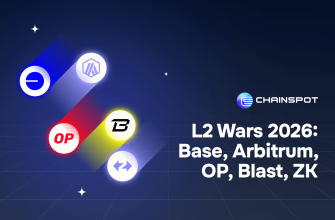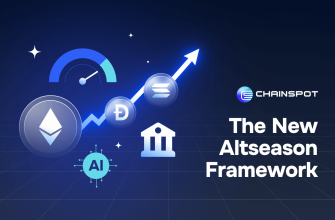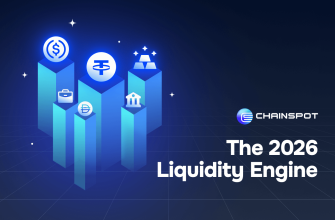- 1. Leverage 101: How Borrowed Buying Power Works
- 2. DEX vs CEX: Why Trade Leveraged Perps On‑Chain?
- 3. The Big Players in 2025
- 3.1 GMX
- 3.2 dYdX v4
- 3.3 Perpetual Protocol v2
- 3.4 Synthetix Perps + Kwenta
- 3.5 Gains Network (gTrade)
- 3.6 Vertex
- 3.7 MUX
- 4. Setting Up: From Wallet to First Trade
- 5. Risk Management Tips
- 6. DEX vs CEX: Comparative Table of Key Metrics
- 7. Why Chainspot Completes Your Leverage Toolkit
- 8. Conclusion
Leverage trading has moved beyond the confines of centralized venues. A new generation of decentralized exchanges (DEXs) now offers perpetual futures and margin products with up to 100× buying power—while letting traders stay in full control of their keys. This in‑depth, 3 000‑word+ guide explains what on‑chain leverage is, how it compares with margin on traditional exchanges, and walks you through the leading DEXs (GMX, dYdX, Perpetual Protocol, Synthetix/Kwenta, Gains Network, Vertex, MUX and more). We end with a practical “how‑to” section and risk‑management checklist—and show why Chainspot is the smartest route to bridge collateral, swap profits, and earn cashback each time you trade.
1. Leverage 101: How Borrowed Buying Power Works
Leverage lets you open a position larger than your capital by posting margin (collateral); profits and losses are magnified accordingly. A 10× long on ETH means a 1 % move in the underlying produces a 10 % change in equity. Liquidations occur when maintenance margin is breached.
On‑chain perpetuals mirror the perpetual swaps popularised by BitMEX, but execution, funding, and liquidation logic live in smart contracts rather than a central orderbook.
2. DEX vs CEX: Why Trade Leveraged Perps On‑Chain?
Self‑custody & transparency. Smart contracts enforce margin rules openly; no exchange can rehypothecate user funds.
Lower counter‑party risk. Funds stay in your wallet until trade execution; collateral is vaulted on chain, not in an exchange hot wallet susceptible to hacks.
Programmable composability. On‑chain positions can be tokenised, used as collateral elsewhere, or automated via DeFi primitives.
Permissionless access. No KYC is required; anyone with a wallet and gas can trade. Note: some front‑ends may geo‑block users, but contracts remain open.
Drawbacks include generally higher fees for small traders (gas), thinner liquidity in certain alt pairs, and dependency on oracle feeds.
3. The Big Players in 2025
| DEX | Max Leverage | Collateral Model | Networks |
|---|---|---|---|
| GMX | up to 50× | Multi‑asset GLP pool | Arbitrum, Avalanche |
| dYdX v4 | up to 20× | Order‑book & off‑chain matching | Cosmos (DYDX chain) |
| Perpetual Protocol v2 | up to 10× | Virtual AMM + USDC vault | Optimism |
| Synthetix Perps (Kwenta) | up to 50× | sUSD debt‑pool | Optimism, Base |
| Gains Network (gTrade) | up to 150× crypto, 1000× FX | Synthetic, DAI vault | Polygon, Arbitrum |
| Vertex | up to 10× perps, unified margin | Order‑book hybrid | Arbitrum, Sei |
| MUX | up to 100× | Aggregated pooled liquidity | Arbitrum, BSC, Avalanche |
(Data reflects public documentation and live main‑net limits as of May 2025.)
3.1 GMX
GMX pioneered oracle‑based zero‑price‑impact perps. Traders pay a variable borrow fee to the GLP liquidity providers and up to 50× leverage is available on majors like BTC, ETH and SOL. A step‑by‑step interface plus on‑chain indicators make it beginner‑friendly, and liquidity is deep thanks to $2 bn+ in GLP TVL during bull spikes.
3.2 dYdX v4
dYdX migrated from StarkEx to its standalone Cosmos chain in 2024, enabling 20× cross‑margin perps with near‑CEX throughput and zero gas fees for takers. Liquidity rivals top tier centralized venues for BTC and ETH pairs, though new assets are gated by governance votes.
3.3 Perpetual Protocol v2
Perp v2 introduced a virtual AMM (vAMM) with concentrated liquidity on Optimism, allowing up to 10× leverage and reduced slippage via maker/taker fee tiers. Funding rates fluctuate based on vAMM skew, visible in‑app.
3.4 Synthetix Perps + Kwenta
Synthetix Perps leverage the protocol’s sUSD debt pool, letting Kwenta front‑end offer up to 50× leverage across dozens of synthetic assets. Kwenta v2 UI simplifies perpetuals, providing 25× default leverage and advanced order types.
3.5 Gains Network (gTrade)
Gains stands out with 150× leverage on crypto and 1000× on forex, using a DAI‑vaulted synthetic model. Traders deposit DAI or bridged collateral, and open positions settle instantly with Chainlink oracles.
3.6 Vertex
Vertex merges an off‑chain order book with on‑chain settlement, offering unified cross‑collateral margin and deep liquidity incentives that propelled it to Arbitrum’s top‑volume slot in 2024. A recent Messari report noted staking participation exceeding 70 % in Q4 2024.
3.7 MUX
MUX aggregates liquidity across multiple chains and provides up to 100× leverage with zero price impact. Its router smart‑contract auto‑routes orders to the best on‑chain venue, similar to how Chainspot handles spot swaps.
4. Setting Up: From Wallet to First Trade
- Acquire collateral. Most perps DEXs accept USDC, USDT, DAI or native assets. Use Chainspot to bridge and swap into the right token on the right chain in one click, saving gas and enjoying cashback.
- Connect wallet. MetaMask or WalletConnect‑compatible wallet for EVM; Keplr or dYdX chain wallet for dYdX v4; etc.
- Deposit margin. Transfer collateral to the protocol (GMX uses in‑contract escrow, Synthetix uses sUSD debt pool, etc.).
- Open a position. Select long/short, input leverage multiplier, choose market price or limit order.
- Monitor metrics. Keep an eye on net value, funding rates, liquidation price and oracle updates.
For a visual tutorial check GMX’s step‑by‑step guide.
5. Risk Management Tips
- Use moderate leverage. Staying under 10× greatly reduces liquidation probability on volatile assets.
- Set stop‑loss orders. Many DEXs support conditional triggers or off‑chain keepers.
- Track funding. Positive funding drains shorts; negative drains longs.
- Diversify across venues. Oracle risk, UI outages or pool skew can vary; spreading positions hedges platform risk.
- Mind gas & latency. During network congestion execution can lag; plan buffer margin.
6. DEX vs CEX: Comparative Table of Key Metrics
| Feature | DEX Perps | Centralized Exchange Margin |
| Custody | Self‑custody | Exchange‑custody |
| Transparency | On‑chain proof | Opaque order books |
| KYC | Usually none | Mandatory on majors |
| Max leverage | 10‑150× depending on protocol | Up to 125× on Binance, Bybit |
| Fees | Smart‑contract + funding + gas | Maker/taker + funding |
| Downtime risk | Smart‑contract bugs/oracle issues | Exchange hacks, solvency risk |
Source comparison drawn from public docs and research.
7. Why Chainspot Completes Your Leverage Toolkit
Leverage traders constantly shuttle collateral between chains and venues—bridging USDC to Arbitrum for GMX, moving ETH to Optimism for Perp v2, or withdrawing profits to Polygon for gTrade. Chainspot’s AI‑routed swaps let you bridge and swap in a single transaction, with:
- Lowest effective fees thanks to route optimisation.
- Fast settlement aided by parallelized cross‑chain infrastructure.
- Cashback + referrals. Earn back a share of every swap and stack extra rewards for inviting fellow traders.
👉 Start optimizing your collateral flows on Chainspot: https://app.chainspot.io
8. Conclusion
On‑chain leverage trading has matured. Perps DEXs now rival centralized venues in liquidity, UI and capital efficiency, while preserving self‑custody and composability. By mastering the mechanics, choosing the right protocol for each asset, and maintaining disciplined risk management, you can harness leverage without surrendering control. Combine that with Chainspot’s cost‑efficient bridging and loyalty perks, and you’re poised to ride 2025’s market swings SAFU—and with style.











